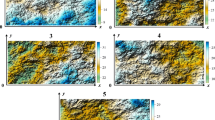Abstract
In view of the limitations of existing 2D research methods and theories, three 3D joint roughness characteristic parameters were put forward in this article, through consulting a great many of studies on rock joint shear mechanism. Those 3D characteristic parameters can reflect both shear properties and anisotropy of rock joint surface. Moreover, based on the 3D high resolution laser scanning technology and GIS technology, the author precisely measured the accidented surface terrain of porphyritic granite joint and extracted the 3D characteristic parameters successfully. What is more, after precisely analysing the roughness features in different directions of a typical rock joint surface, a new computational Equation of JRC3D was obtained.
Access this chapter
Tax calculation will be finalised at checkout
Purchases are for personal use only
Similar content being viewed by others
References
Barton N, Choubey V (1977) The shear strength of rock joints in theory and practice. J Rock Mech 10(1):1–54
Cao P, Fan X, Pu C et al (2011) Shear test of joint and analysis of morphology characteristic evolution of joint surface. Chin J Rock Mech Eng 30(3):480–485 (in Chinese)
Dong WP, Sullivan PJ, Stout KJ (1994) Comprehensive study of parameters for characterization 3-D surface terrain-III. Wear 178(1):29–60
Du SJ (1997) Experimental and theoretical research on geometrical-mechanical-hydromechanical characteristics of rock joints. Ph. D. Thesis, Tongji University, Shanghai
Du SJ, Liu H, Shen SL et al (2004) Simulation of the compression and flow process in a rock joint by using GIS. Int J Rock Mech Min Sci 41(3):1–6
Kulatilake PHSW, Um J, Pan G (1997) Requirement for accurate quantification of self-affine roughness using the line scaling method. Rock Mech Rock Eng 30(4):181–206
Acknowledgments
This research was financially supported by the National Natural Science Foundation of China (Grant No. 41302245).
Author information
Authors and Affiliations
Corresponding author
Editor information
Editors and Affiliations
Rights and permissions
Copyright information
© 2015 Springer International Publishing Switzerland
About this paper
Cite this paper
Li, H., Huang, R., Xu, X., Xiao, J., Zhong, X. (2015). The Study on the Determination Method of 3D Joint Roughness Coefficient. In: Lollino, G., et al. Engineering Geology for Society and Territory - Volume 2. Springer, Cham. https://doi.org/10.1007/978-3-319-09057-3_354
Download citation
DOI: https://doi.org/10.1007/978-3-319-09057-3_354
Published:
Publisher Name: Springer, Cham
Print ISBN: 978-3-319-09056-6
Online ISBN: 978-3-319-09057-3
eBook Packages: Earth and Environmental ScienceEarth and Environmental Science (R0)



